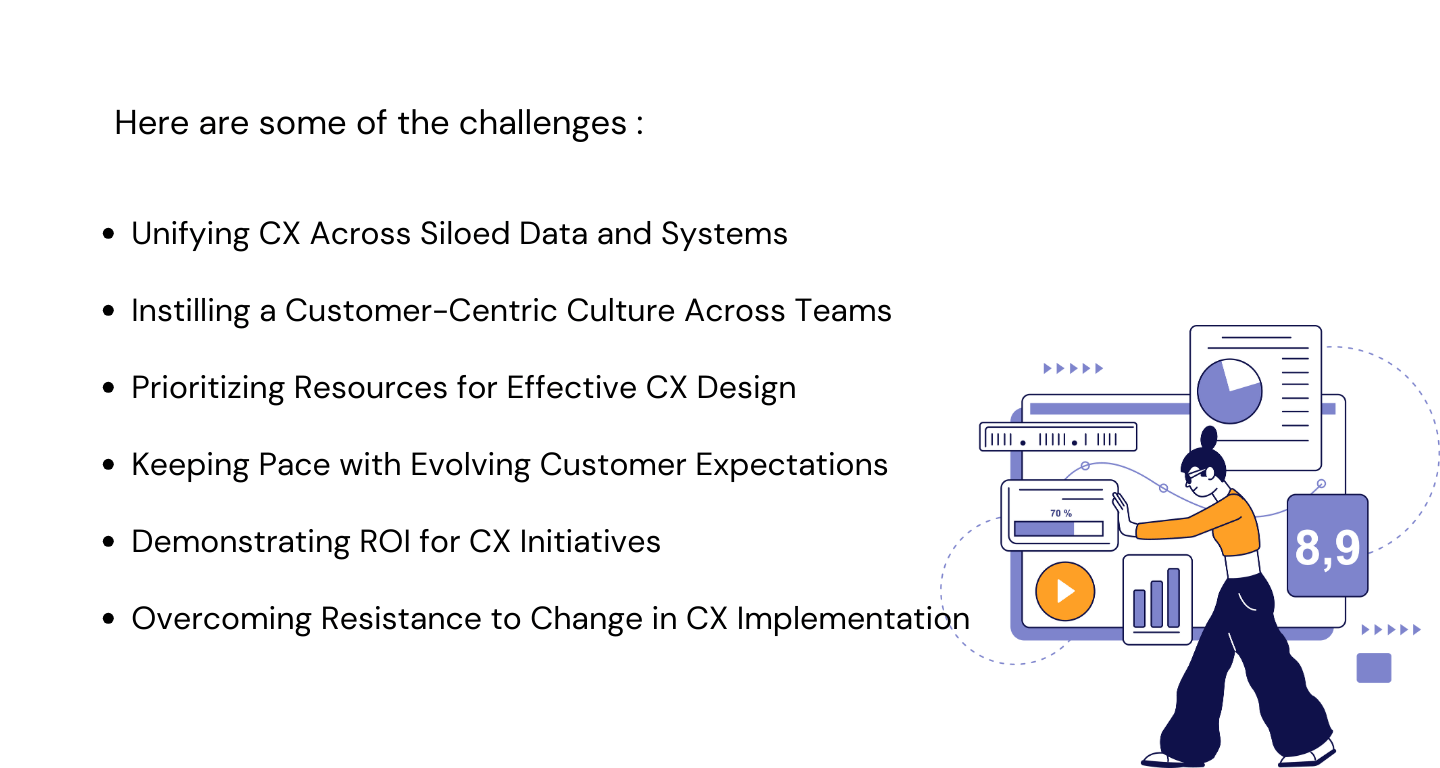Customer Experience
Customer Experience Design Demystified
Article written by Kate Williams
Content Marketer at SurveySparrow
11 min read
19 September 2025

When did you last interact with a brand and felt…mesmerized? Maybe it was about how they handled your issue, or maybe the app just knew what you needed before you even asked! These moments of delight result from the relentless effort put forth by a brand in customer experience design.
This blog will show you how to captivate your audience, win their hearts, and make them fall head over heels for your brand.
So, let’s start with…
What is Customer Experience Design?
Customer experience design, often called CX design, revolves around designing experiences with a customer-centric approach. It involves aligning every touchpoint, from initial awareness to post-purchase support. It ensures a seamless and memorable journey for customers.
What needs to be stressed is that these instances are intentionally created.
To design remarkable experiences, CX designers blend elements of psychology, design thinking, and data analysis. They use insights to shape products, services, and interactions that exceed expectations. The end goal is to understand customer needs, desires, and pain points deeply.
Key Principles of CX Design
When designing experiences, you need to consider several aspects. Let’s explore some of these principles followed by designers to create exceptional CX:
#1 Empathy
It starts with empathy. Designers put themselves in the customers’ shoes to understand their perspectives, emotions, and motivations. By empathizing with customers, businesses can anticipate their needs and deliver personalized experiences.
#2 Consistency
Consistency is crucial! Customers expect seamless experiences across different channels and touchpoints. Maintaining a consistent brand voice fosters trust and loyalty.
#3 Simplicity
Simplicity is the ultimate sophistication in CX design. By removing complexities and streamlining processes, businesses can provide effortless experiences. Customers appreciate intuitive interfaces, clear communication, and easy-to-navigate websites that save them time and effort.
Read More: What is Customer Experience?
What is the difference between CX and UX?
Customer Experience and User Experience are two closely related concepts. Both focus on enhancing interactions with a brand or product. While they share similarities, they have distinct foci and scopes.
| CX | UX |
| Focuses on overall brand interactions | Concentrates on specific product/service interactions |
| Encompasses entire customer journey | Primarily focuses on product/interface usability |
| Considers emotions and satisfaction | Emphasizes ease of use and efficiency |
| Involves multiple departments | Associated with design and development teams |
| Aims for loyalty and advocacy | Aims for user engagement and satisfaction |
| Measures with NPS, CSAT, CES | Measures with usability testing, feedback, task completion |
Now, Both CX and UX are crucial when it comes to the growth of a brand. It would be handy to have an advanced tool to back you up. Try SurveySparrow once, and you’ll understand why. This experience management platform lets you create tailored memories for your customers. You can sweep them off with engaging forms, advanced analytics, and a conversational interface!
I can’t go without mentioning the CX module. It includes journey maps, product feedback, transactional and relational NPS, CSAT, CES, exit surveys, and event feedback. Get a detailed view of customer sentiment and engagement! Plus, the AI surveys will make your life so much easier.
Why don’t you try it out? A 14-day free trial will give you an idea of what you want.
Sign up for free today!

Craft Experiences Customers Crave!
A personalized walkthrough by our experts. No strings attached!
Importance of Customer Experience (CX) Design
Why does it matter?
Crafting experiences is about putting your customers at the heart of your business strategy. By prioritizing their needs and desires, you can create experiences that meet and exceed their expectations. Here are a few reasons why it matters:
Enhances Customer Satisfaction
By designing seamless, intuitive, personalized experiences, you can leave a lasting impression on your customers. Satisfied customers are more likely to become loyal advocates for your brand.
Read More: What is a Good CSAT Score?
Drives Customer Loyalty and Retention
Customers who feel understood, valued, and appreciated are likelier to stay loyal to your brand. A positive experience can turn a one-time buyer into a repeat customer. This increases customer lifetime value.
Differentiates Your Brand
In a crowded marketplace where products and services can be easily replicated, customer experience becomes a crucial differentiator. By delivering exceptional experiences, you can stand out from the competition and create a strong brand identity.
Boosts Word-of-Mouth Marketing
Happy customers are eager to share their positive experiences with others. Understanding them and taking prompt action can turn your customers into brand advocates, amplifying your reach and attracting new customers.
The CX Design Process
There is a systematic process to ensure the successful implementation of customer-centric strategies. Here’s a glimpse into that:
1. Research and Analysis
Start by understanding your customers’ needs, pain points, and expectations. Conduct user research, collect feedback, and analyze customer data to uncover valuable insights.
2. Journey Mapping
Map out the customer journey to identify key touchpoints and pain points. This visual representation helps you pinpoint areas for improvement and design better experiences. Perhaps you can try creating a journey map with SurveySparrow to understand it better.
Read More: What is the Customer Experience Journey?
3. Ideation and Prototyping
Brainstorm ideas and create prototypes to visualize and test your CX concepts. Iterate and refine your designs based on user feedback and usability testing.
4. Implementation
Once you have a refined design, it’s time to implement it across all touchpoints. Collaborate with cross-functional teams to ensure consistency and alignment with your brand’s vision.
We know the importance now, but why should we invest so much time here?
Benefits of CX Design
Increased satisfaction is one thing, But what else? These reasons will be enough to make you believe in its importance:
- Increased Customer Retention: Those with a great experience are more likely to return for more. They’ll stick with your brand and boost loyalty.
- Enhanced Brand Reputation: Trust in your brand will get a positive and appealing image. What more should you ask for?
- Higher Customer Lifetime Value: Customers who enjoy interacting with your brand will likely spend more over time. This increases their lifetime value and boosts your profits.
- Improved Crisis Management: You can navigate challenges smoothly, maintain trust, and emerge from crises with your reputation intact.
What’s more? Ah, personalization.
Effective Strategies for Personalizing the CX
Here are some effective strategies and best practices to consider:
- Get to Know Your Customers: It starts with deeply understanding your customers. Collect data and analyze their preferences, purchase history, and interactions to know their unique needs and desires.
- Segment and Target: Once you have a treasure trove of customer data, segment your audience into smaller groups based on shared characteristics. This allows you to create targeted campaigns and messages that resonate with each segment.
- Personalized Communication: Speak to your customers like you would to a friend. Address them by name, send tailored messages, and make recommendations based on their previous interactions. Let them know you understand their individuality.
- Customized Product or Service Recommendations: Utilize the power of AI and machine learning to offer personalized product or service recommendations. Show your customers you know what they love and suggest relevant options matching their preferences.
- Adaptive Website and App Experiences: Create dynamic experiences that adapt to each customer’s preferences and behavior. From personalized landing pages to customized product displays, make their journey feel uniquely tailored to their interests.
Read More: 30 Effective Customer Experience Strategies
Challenges to implementing an effective design

Siloed Data and Systems
Creating a seamless and holistic CX becomes difficult when different departments or teams work in isolation. Breaking down these silos and integrating data and systems is key to delivering a unified and consistent experience.
Lack of Customer-Centric Culture
Organizations may struggle with creating a customer-centric culture where every employee understands the importance of delivering exceptional experiences. Overcoming this challenge involves aligning the entire organization around the customer and promoting a culture of empathy and customer focus.
Limited Resources and Budget
Implementing an effective design often requires investments in technology, training, and resources. Businesses need to prioritize and allocate resources strategically to achieve maximum impact within their means.
Evolving Customer Expectations
Customer expectations are constantly evolving. They are driven by technological advancements, industry trends, and their experiences with other brands. Maintaining these ever-changing expectations and staying ahead of the curve can be challenging. It requires businesses to be proactive, adaptable, and continuously innovative to meet and exceed customer expectations.
Measuring and Demonstrating ROI
While investing in a design is crucial, businesses must measure and demonstrate the return on investment (ROI) to justify these efforts. Determining the right metrics and effectively measuring the impact of CX initiatives can be challenging. It requires clear goals, proper tracking mechanisms, and connecting improvements with tangible business outcomes.
Resistance to Change
Overcoming resistance to change and gaining buy-in from stakeholders is essential. Clear communication, education, and the involvement of key stakeholders can help navigate this challenge.
Think of a Customer Experience Design in Action…
The first thing that comes to my mind is… Disney! Where dreams come true” Literally!
Disney is synonymous with magical experiences, and their attention to detail in CX design is unmatched. From the moment guests step foot in a Disney park, they are immersed in enchantment.
They focus on every aspect of the guest experience, including the friendly staff, well-designed attractions, and personalized touches, creating unforgettable memories for visitors.
Disney has also mastered the art of design through MagicBands. These wearable bands are an all-in-one device for park admission, hotel room access, FastPass reservations, and even cashless purchases.
MagicBands gives visitors a frictionless and immersive experience, eliminating the need for physical tickets, cash, or multiple cards. Moreover, the seamless integration of technology and design enhances the overall experience and fully immerses guests in Disney’s magical world.
Conclusion
Customer experience design is a transformative discipline that has the power to elevate your business and leave a lasting impact on your customers. By understanding the principles of CX design, following a systematic process, and leveraging the right tools like SurveySparrow, you can create remarkable experiences that resonate with your customers.
Remember, it is an ongoing journey. You must continuously seek feedback, analyze data, and adapt your strategies to meet evolving customer needs. And that’s how you truly embrace the power of CX design and unlock the full potential of your business.
14-day free trial • Cancel Anytime • No Credit Card Required • No Strings Attached
FAQs
1. What does a CX designer do?
A CX designer creates experiences that make customers happy when interacting with a product or service. They focus on understanding customers’ needs and wants and then design ways to meet them, like making websites easy to use or improving customer service.
Their goal is to make customers enjoy their experience so they return.
2. How can we optimize CX design?
To optimize CX design:
- Understand customers
- Streamline interactions
- Personalize experiences
- Empower employees
- Continuously improve
3. How do you measure the success of CX design?
Success is often measured through metrics like Net Promoter Score (NPS), Customer Satisfaction Score (CSAT), and Customer Effort Score (CES).

Make your customers feel heard. Turn feedback into loyalty with SurveySparrow's CX platform.
Kate Williams
Related Articles

Customer Experience
How to Create the Best Customer Service Experience
10 MINUTES
19 June 2023

Customer Experience
Customer Experience Lifecycle: A Comprehensive Guide
11 MINUTES
25 September 2023

Customer Experience
7 Ways to Cut Down Your Customer Churn Rate
14 MINUTES
14 July 2018

Customer Experience
What is Customer Experience Analysis: A Comprehensive Guide
13 MINUTES
7 March 2023
